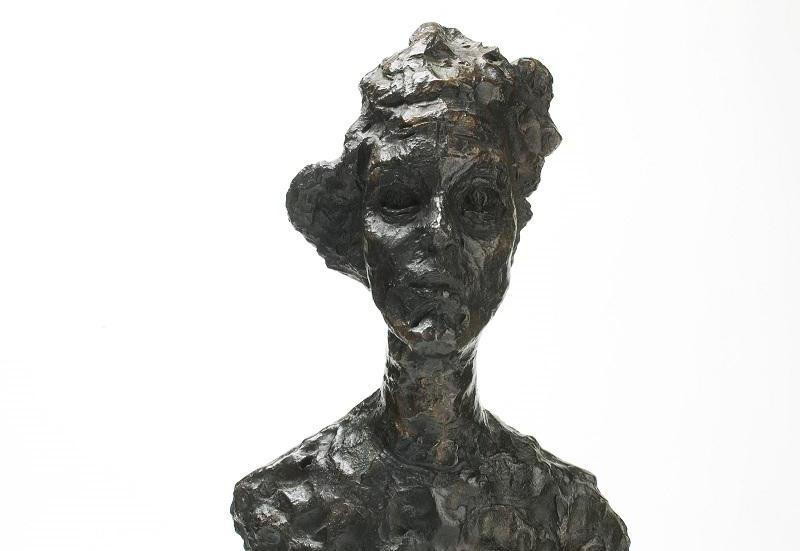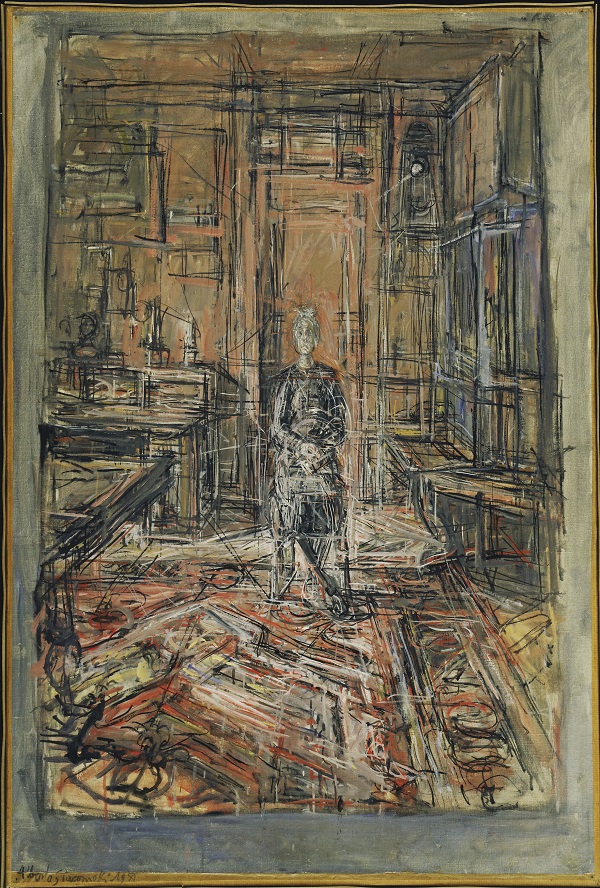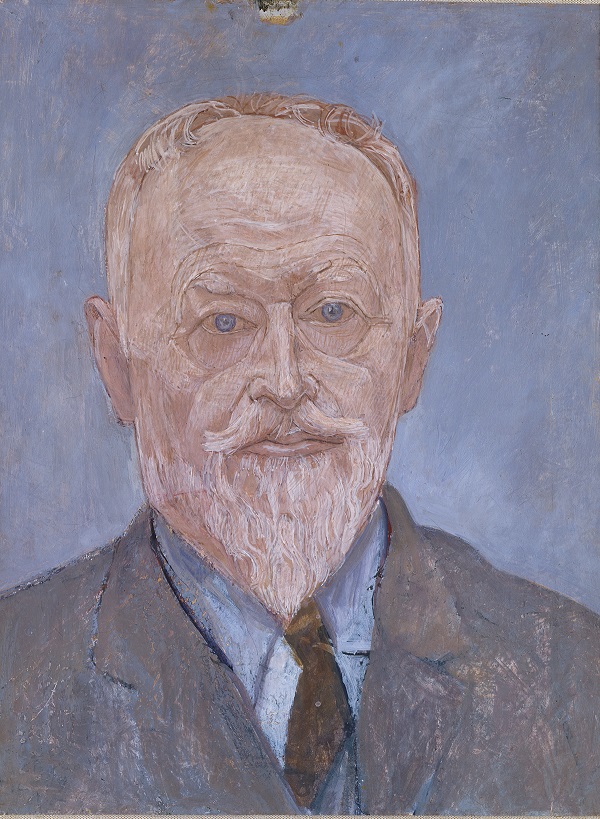Giacometti, National Portrait Gallery | reviews, news & interviews
Giacometti, National Portrait Gallery
Giacometti, National Portrait Gallery
A lifetime of portraiture reveals a secret double life

Any number of puzzling and fantastical stories were told by Alberto Giacometti in the construction of a personal mythology that helped secure his reputation as an archetypal artist of the avant-garde. Less heroic than the oft-quoted accounts of his transformative, visionary experiences, the story of his return to Paris after the Second World War is no less poignant, nor significant for all that.
The pessimism and isolation perceived in some of his best known work suggests a solitary, aloof persona, but in fact Giacometti seems to have been a gregarious, talkative character. His meagre studio, where he lived and worked from 1927 until his death in 1966, was a magnet for artists and writers including Simone de Beauvoir, Samuel Beckett and Jean-Paul Sartre, the writer Michael Peppiatt describing the studio as Giacometti’s “most complete creation, the matrix and archive of his art”.
 In specially designed galleries that evoke the deep, well-like proportions of the studio, lit from up high by a large window, we are made aware of the space that surrounds the works as a presence rather than an absence, a tangible entity that engages in an interplay of mass and space. The notion of space as an active presence recurs in Giacometti’s work, and in a series of portrait busts from the 1950s, his wife Annette could have been forged in the elements, lumpen, partially formed surfaces appearing impermanent and fluid, the ragged edges dissolving into or emerging from the surrounding space. (Main picture: Annette VI, 1962)
In specially designed galleries that evoke the deep, well-like proportions of the studio, lit from up high by a large window, we are made aware of the space that surrounds the works as a presence rather than an absence, a tangible entity that engages in an interplay of mass and space. The notion of space as an active presence recurs in Giacometti’s work, and in a series of portrait busts from the 1950s, his wife Annette could have been forged in the elements, lumpen, partially formed surfaces appearing impermanent and fluid, the ragged edges dissolving into or emerging from the surrounding space. (Main picture: Annette VI, 1962)
In a painting from 1950, The Artist’s Mother threatens to disappear into her surroundings, the details of the room contrasting with her insubstantial, wraith-like figure (pictured above right). She occupies a central point at which the lines articulating a heavily-furnished interior converge, but instead of lending weight to her presence, the attempt to anchor her only makes her seem more ethereal. Similarly, in his Bust of Annette, 1954, construction lines seem to be a way of holding down the features of the face, a struggle described by Giacometti in typically colourful terms: “The distance between one wing of the nose and the other is like the Sahara, it has no limits, nothing to be fixed, everything escapes.” On other occasions, as in the Bust of Diego, 1955, the weight of tangible space appears sufficient to crush matter, the shape of the head flattened and made small as if condensed by errant atmospheric pressure.
In the final room, the quality of light changes dramatically, daylight replaced with the nicotine-yellow of the gas-lamps that lit Giacometti’s studio after dark, when he made painting after painting of Caroline, his final model who sat for him over a period of five years. The airless claustrophobia of this room echoes the paintings themselves, in which Giacometti gradually closes in on his subject, each painting narrowing its focus, so that in the final canvas, Caroline’s face, and specifically her eyes, are all that remain. In these final canvases, the faces thick with paint as Giacometti repeatedly and obsessively scrutinised and copied his single subject, we have evidence of the artist’s constant and ultimately futile battle to capture the world – as elusive as shadows – just as he saw it.
While the partial recreation of the studio provides a sympathetic setting for the work displayed here, it is also key to exploring what curator Paul Woodhouse describes as Giacometti’s double life. While portraiture was undoubtedly Giacometti’s focus in the final 20 years of his life, it was in fact a constant and coherent strand of endeavour that began during childhood and continued unabated until his death.
 The work for which he is famous, the Surrealist sculptures and the anonymous stick figures that have come to be seen as the very embodiment of existentialism, were all produced in Paris, while visits to his family home in Switzerland provided the setting for Giacometti’s exploration of portraiture, an activity that seems to have been kept secret from his avant-garde friends in France. It is startling to realise that one of his most celebrated Surrealist sculptures, Woman with Her Throat Cut, 1932, was made in the same year as the naturalistic Portrait of the Artist’s Father, c.1932 (Pictured above), and nor was this an anomaly: throughout his Surrealist years Giacometti continued to explore portraiture, his father, the Post-Impressionist painter Giovanni Giacometti, ignorant of, although more likely turning a disapproving blind eye to his son’s involvement with the Surrealists.
The work for which he is famous, the Surrealist sculptures and the anonymous stick figures that have come to be seen as the very embodiment of existentialism, were all produced in Paris, while visits to his family home in Switzerland provided the setting for Giacometti’s exploration of portraiture, an activity that seems to have been kept secret from his avant-garde friends in France. It is startling to realise that one of his most celebrated Surrealist sculptures, Woman with Her Throat Cut, 1932, was made in the same year as the naturalistic Portrait of the Artist’s Father, c.1932 (Pictured above), and nor was this an anomaly: throughout his Surrealist years Giacometti continued to explore portraiture, his father, the Post-Impressionist painter Giovanni Giacometti, ignorant of, although more likely turning a disapproving blind eye to his son’s involvement with the Surrealists.
The author of a large and coherent body of work made effectively in secret, Giacometti is cast as a less than reliable witness to his own practice, his own self-mythologising combining with his role as a beacon of existentialism to eclipse a more complex, nuanced figure. When in 1925, frustrated by his failure to copy reality as he perceived it, he proclaimed that he would “abandon the real”, his work became increasingly abstract, his Paris output moving away from observed reality as he explored themes of sexual violence, with sculptures apparently arriving in his imagination fully realised.
Nevertheless, the great revelation of this exhibition is that parallel to this, he did in fact continue to explore portraiture, producing a remarkable series of portraits of his parents in which he returns again and again to the same sitters, using a range of representational modes, in drawing, painting and sculpture, to produce an equivalent to what he saw before him.
For an artist who said: “I have enough trouble with the outside without bothering with the inside”, there are portraits here that have an intense emotional charge, such as his final piece, a sculpture of his brother Diego. It was made from memory, and in its roughly hewn form you can sense the dying artist fondly moulding the familiar contours of his brother’s head, its small scale suggesting the receding vision of a man departing from life.
Explore topics
Share this article
The future of Arts Journalism
You can stop theartsdesk.com closing!
We urgently need financing to survive. Our fundraising drive has thus far raised £33,000 but we need to reach £100,000 or we will be forced to close. Please contribute here: https://gofund.me/c3f6033d
And if you can forward this information to anyone who might assist, we’d be grateful.

Subscribe to theartsdesk.com
Thank you for continuing to read our work on theartsdesk.com. For unlimited access to every article in its entirety, including our archive of more than 15,000 pieces, we're asking for £5 per month or £40 per year. We feel it's a very good deal, and hope you do too.
To take a subscription now simply click here.
And if you're looking for that extra gift for a friend or family member, why not treat them to a theartsdesk.com gift subscription?
more Visual arts
 Help to give theartsdesk a future!
Support our GoFundMe appeal
Help to give theartsdesk a future!
Support our GoFundMe appeal
 Ed Atkins, Tate Britain review - hiding behind computer generated doppelgängers
Emotions too raw to explore
Ed Atkins, Tate Britain review - hiding behind computer generated doppelgängers
Emotions too raw to explore
 Echoes: Stone Circles, Community and Heritage, Stonehenge Visitor Centre review - young photographers explore ancient resonances
The ancient monument opens its first exhibition of new photography
Echoes: Stone Circles, Community and Heritage, Stonehenge Visitor Centre review - young photographers explore ancient resonances
The ancient monument opens its first exhibition of new photography
 Hylozoic/Desires: Salt Cosmologies, Somerset House and The Hedge of Halomancy, Tate Britain review - the power of white powder
A strong message diluted by space and time
Hylozoic/Desires: Salt Cosmologies, Somerset House and The Hedge of Halomancy, Tate Britain review - the power of white powder
A strong message diluted by space and time
 Mickalene Thomas, All About Love, Hayward Gallery review - all that glitters
The shock of the glue: rhinestones to the ready
Mickalene Thomas, All About Love, Hayward Gallery review - all that glitters
The shock of the glue: rhinestones to the ready
 Interview: Polar photographer Sebastian Copeland talks about the dramatic changes in the Arctic
An ominous shift has come with dark patches appearing on the Greenland ice sheet
Interview: Polar photographer Sebastian Copeland talks about the dramatic changes in the Arctic
An ominous shift has come with dark patches appearing on the Greenland ice sheet
 Donald Rodney: Visceral Canker, Whitechapel Gallery review - absence made powerfully present
Illness as a drive to creativity
Donald Rodney: Visceral Canker, Whitechapel Gallery review - absence made powerfully present
Illness as a drive to creativity
 Noah Davis, Barbican review - the ordinary made strangely compelling
A voice from the margins
Noah Davis, Barbican review - the ordinary made strangely compelling
A voice from the margins
 Best of 2024: Visual Arts
A great year for women artists
Best of 2024: Visual Arts
A great year for women artists
 Electric Dreams: Art and Technology Before the Internet, Tate Modern review - an exhaustive and exhausting show
Flashing lights, beeps and buzzes are diverting, but quickly pall
Electric Dreams: Art and Technology Before the Internet, Tate Modern review - an exhaustive and exhausting show
Flashing lights, beeps and buzzes are diverting, but quickly pall
 ARK: United States V by Laurie Anderson, Aviva Studios, Manchester review - a vessel for the thoughts and imaginings of a lifetime
Despite anticipating disaster, this mesmerising voyage is full of hope
ARK: United States V by Laurie Anderson, Aviva Studios, Manchester review - a vessel for the thoughts and imaginings of a lifetime
Despite anticipating disaster, this mesmerising voyage is full of hope

Add comment